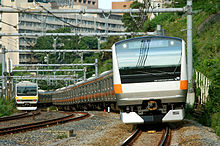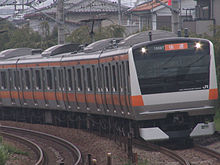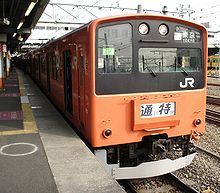- Chūō Line (Rapid)
-
This article is about rapid services on the Chūō Line. For local services on the Chūō Line, see Chūō-Sōbu Line. For the entire Chūō Line between Tokyo and Nagoya, see Chūō Main Line.
 Chūō Line (Rapid) E233 series (right) and Chūō-Sōbu Line E231 series (June 2007)
Chūō Line (Rapid) E233 series (right) and Chūō-Sōbu Line E231 series (June 2007)
The Chūō Line (Rapid) (中央線快速 Chūō-sen kaisoku) is the name given to rapid services on the eastern section of the Chūō Main Line operated by the East Japan Railway Company (JR East) between Tokyo and Takao stations.
Contents
Basic data
- Operator: East Japan Railway Company (Services and tracks)
- Tokyo – Takao: 53.1 km (33.0 mi)
- Gauge: 1,067 mm (3 ft 6 in)
- Stations: 24
- Double-tracked section: Entire line
- Electrification: 1,500 V DC
- Railway signalling: ATS
- CTC center: Tokyo Operations Control Center
- Maximum speed: 95 km/h (59 mph)
Services
Although the Chūō Line (Rapid) designation only refers to the section between Tokyo and Takao stations, many trains continue on past Takao to Ōtsuki. These include both limited express and various special rapid services. For details, see the Chūō Main Line article. In addition, Chūō Line (Rapid) trains do not stop at some stations between Ochanomizu and Nakano stations; for information on those services, see the Chūō-Sōbu Line article.
The Chūō Line (Rapid) uses the two express tracks on the four-track section between Ochanomizu and Mitaka stations. Past Mitaka, trains use both tracks on the remaining double-track section. Since the express tracks do not have platforms at several stations in central Tokyo, even the slowest services of the Chūō Line (Rapid) skip such stations and are therefore called "Rapid" (快速). In addition to the basic type of "Rapid", there are some variations of the service types with fewer stops.
- Rapid
- This service is the most common on the Chūō Line (Rapid) route; they stop at all stations west of Nakano except that on weekends and holidays, trains do not stop at Asagaya, Kōenji, or Nishi-Ogikubo stations. The signature color of the rolling stock, station signs and line diagrams is orange (■).
- Chūō Special Rapid • Ōme Special Rapid
- Four services per hour in off-peak hours make limited stops between Tokyo and Tachikawa, and stop at all stations west of Tachikawa. Chūō Special Rapid stays on the Chūō Main Line to Takao and Ōtsuki while Ōme Special Rapid spurs to the Ōme Line. The service's signature color on service diagrams is blue (■) for Chūō Special Rapid and green (■) for Ōme Special Rapid.
- Commuter Rapid
- Commuter Rapid service operates weekday evening. The service's signature color on service diagrams is purple (■). It stops at Ogikubo and Kichijōji in addition to the stops of Chūō Special Rapid.
- Commuter Special Rapid
- Weekday morning services for Tokyo; two from Ōtsuki, two from Ōme and one from Takao. The service's signature color on service diagrams is pink (■).
Chūō/Ōme Liners
The Chūō Liner and Ōme Liner services run on weekday peak periods only. There is one Chūō Liner from Takao for Tokyo in the morning and six in the evenings from Tokyo for Takao and Hachioji. The Ōme Liner has one service during the morning from Ōme and two in the evening from Tokyo. Unlike other rapid services, the Chūō/Ōme Liners require the purchase of a liner ticket in addition to the base fare; all seats are unreserved, but the number of liner tickets solid is limited to the number of seats available. Liner services are provided by E257 series 11-car or 9-car EMUs (introduced in July 2002) and E351 series 12-car EMUs (introduced in March 2008).
Chūō Liners stop at: Tokyo - Shinjuku - Hachiōji - (Takao) Ōme Liners stops at: Tokyo - Shinjuku - Tachikawa - Haijima - Kabe - Ōme
History
Most of the route of the Chūō Line (Rapid) was built by the Kōbu Railway and later acquired by the Japanese Government Railways in 1906.
Operation of electric multiple unit (EMU) trains on the Chūō Main Line began in 1904. By 1930, the EMU service had reached Tokyo to the east and Asakawa (now Takao) to the west. In 1933, two tracks were added to the existing double-tracked section between Ochanomizu and Iidamachi stations (later closed) to complete the four-track line between Ochanomizu and Nakano. On these additional tracks, express trains (急行電車 kyūkō densha), which skipped all stations except Yotsuya and Shinjuku, were introduced the same year. The express service was renamed to "Rapid" (快速 kaisoku) service in March 1961.
Initially, the operation of express/rapid services was limited to weekday peak periods only. Express service began on weekends on March 5, 1944; daytime non-peak operation began on November 9, 1959, but it was limited to weekdays only until April 28, 1966.
Manseibashi Station, located between Kanda and Ochanomizu, was closed in 1943. On the section east of Takao, only Nishi-Kokubunji Station (opened in 1973) and Nishi-Hachiōji Station (opened in 1939) were opened after the start of rapid services.
- August 20, 1979: 201 series EMUs introduced
- March 16, 1991: Ohayō Liner Takao/Ōme and Home Liner Takao/Ōme begin operation
- April 10, 1993: Kokubunji Station added to Ōme Special Rapid stops; Commuter Special Rapid begins operation
- December 1, 1997: Chūō Main Line-bound 115 series EMUs no longer service Shinjuku Station
- October 5, 2005: Women-only cars introduced
- December 26, 2006: E233 series EMUs introduced
The Chūō Rapid Line is known for a high number of suicides, primarily due to the high speed at which some trains pass through stations on the line.[1]
Station list

- All stations are located in Tokyo.
- For information on the Chūō Line west of Takao, please see the Chūō Main Line article.
- Information on the Azusa, Kaiji, and other limited express and seasonal trains can be found on their respective pages.
- Legend
- ●・○: All trains stop (○: mornings and evenings only)
- |: All trains pass
- ◆: All trains pass on weekends and holidays
- ◇: Outbound trains originating from Shinjuku pass
- ∥: Trains do not run over this section of track
Name Japanese Distance (km) Rapid Comm.
RapidSpecial
RapidŌme
Special
RapidComm.
Special
RapidChūō
/Ōme
LinersTransfers Location Between
StationsTotal Tokyo 東京 - 0.0 ● ● ● ● ● ● Tōhoku Shinkansen, Jōetsu Shinkansen, Nagano Shinkansen, Yamanote Line, Keihin-Tōhoku Line, Tōkaidō Line, Sōbu Line (Rapid), Yokosuka Line, Keiyō Line
Tōkaidō Shinkansen
Tokyo Metro Marunouchi Line (M-17)Chiyoda Kanda 神田 1.3 1.3 ● ● ● ● ● | Yamanote Line, Keihin-Tōhoku Line
Tokyo Metro Ginza Line (G-13)Ochanomizu 御茶ノ水 1.3 2.6 ● ● ● ● ● | Chūō-Sōbu Line (Local)
Tokyo Metro Marunouchi Line (M-20), Tokyo Metro Chiyoda Line (Shin-Ochanomizu) (C-12)Yotsuya 四ツ谷 0.8 6.6 ● ● ● ● ● | Chūō-Sōbu Line (Local)
Tokyo Metro Marunouchi Line (M-12), Tokyo Metro Namboku Line (N-08)Shinjuku Shinjuku 新宿 0.7 10.3 ● ● ● ● ● ● Yamanote Line, Chūō-Sōbu Line (Local), Saikyō Line, Shōnan-Shinjuku Line
Odakyū Odawara Line
Keiō Line, Keiō New Line
Tokyo Metro Marunouchi Line (M-08)
Toei Shinjuku Line (S-01), Toei Ōedo Line (E-01, E-27)
Seibu Shinjuku Line (Seibu-Shinjuku)Nakano 中野 1.9 14.7 ● ● ◇ ● | | Tokyo Metro Tōzai Line (T-01) Nakano Kōenji 高円寺 1.4 16.1 ◆ | | | | | Suginami Asagaya 阿佐ケ谷 1.2 17.3 ◆ | | | | | Ogikubo 荻窪 1.4 18.7 ● ● | | | | Tokyo Metro Marunouchi Line (M-01) Nishi-Ogikubo 西荻窪 1.9 20.6 ◆ | | | | | Kichijōji 吉祥寺 1.9 22.5 ● ● | | | | Keiō Inokashira Line Musashino Mitaka 三鷹 1.6 24.1 ● ● ● ● | | Mitaka Musashi-Sakai 武蔵境 1.6 25.7 ● | | | | | Seibu Tamagawa Line Musashino Higashi-Koganei 東小金井 1.7 27.4 ● | | | | | Koganei Musashi-Koganei 武蔵小金井 1.7 29.1 ● | | | | | Kokubunji 国分寺 2.3 31.4 ● ● ● ● ● | Seibu Kokubunji Line, Seibu Tamako Line Kokubunji Nishi-Kokubunji 西国分寺 1.4 32.8 ● | | | | | Musashino Line Kunitachi 国立 1.7 34.5 ● | | | | | Kunitachi Tachikawa 立川 3.0 37.5 ● ● ● ● ● ● Ōme Line (some trains through to/from Tokyo), Nambu Line
Tama Toshi Monorail Line (Tachikawa-Kita, Tachikawa-Minami)Tachikawa Hino 日野 3.3 40.8 ● ● ● Through to/
from Ōme Line| | Hino Toyoda 豊田 2.3 43.1 ● ● ● | | Hachiōji 八王子 4.3 47.4 ● ● ● ● ● Yokohama Line, Hachikō Line
Keiō Line (Keiō-Hachiōji)Hachiōji Nishi-Hachiōji 西八王子 2.4 49.8 ● ● ● | | Takao 高尾 3.3 53.1 ● ● ● ● ● Chūō Main Line (some trains through to Ōtsuki)
Keiō Takao LineRolling stock
- Rapid・Commuter Special Rapid・Chūō Special Rapid・Ōme Special Rapid ・Commuter Rapid
- E233 series (from December 2006)
- Chūō Liner / Ōme Liner
- E257 series (from July 2002)
- E351 series (from March 15, 2008)
Rolling stock used in past
- 72 series
- 101 series
- 103 series
- 201 series
- Chūō Liner / Ōme Liner
- 183 series (March 14, 1991 - March 14, 2008)
See also
References
- ^ French, Howard W. (6 June 2000). "Kunitachi City Journal; Japanese Trains Try to Shed a Gruesome Appeal". Health (The New York Times). http://query.nytimes.com/gst/fullpage.html?sec=health&res=9907E2DC173FF935A35755C0A9669C8B63&scp=1&sq=chuo%20japan%20suicide&st=cse. Retrieved 2008-09-20.
External links
JR East lines Shinkansen 
Main Local Agatsuma · Akabane · Aterazawa · Ban'etsu East · Ban'etsu West · Echigo · Gonō · Hachikō · Hachinohe · Hakushin · Hanawa · Iiyama · Ishinomaki · Itō · Itsukaichi · Iwaizumi · Jōban · Jōetsu · Kamaishi · Karasuyama · Kashima · Kawagoe · Keiyō · Kesennuma · Kitakami · Koumi · Kururi · Mito · Musashino · Nambu · Narita · Negishi · Nikkō · Ōfunato · Oga · Ōito · Ōme · Ōminato · Rikuu East · Rikuu West · Ryōmō · Sagami · Senseki · Senzan · Shinonoi · Sotobō · Suigun · Tadami · Takasaki · Tazawako · Tōgane · Tsugaru · Tsurumi · Uchibō · Yahiko · Yamada · Yamanote · Yokohama · Yokosuka · YonesakaOthers Chūō Rapid · Chūō-Sōbu · Gala-Yuzawa · Keihin-Tōhoku · Saikyō · Shōnan-Shinjuku · Sōbu Rapid · (Tōhoku Jūkan - under construction)Past Categories:- Chūō Main Line
- 1067 mm gauge railways in Japan
- Operator: East Japan Railway Company (Services and tracks)
Wikimedia Foundation. 2010.


